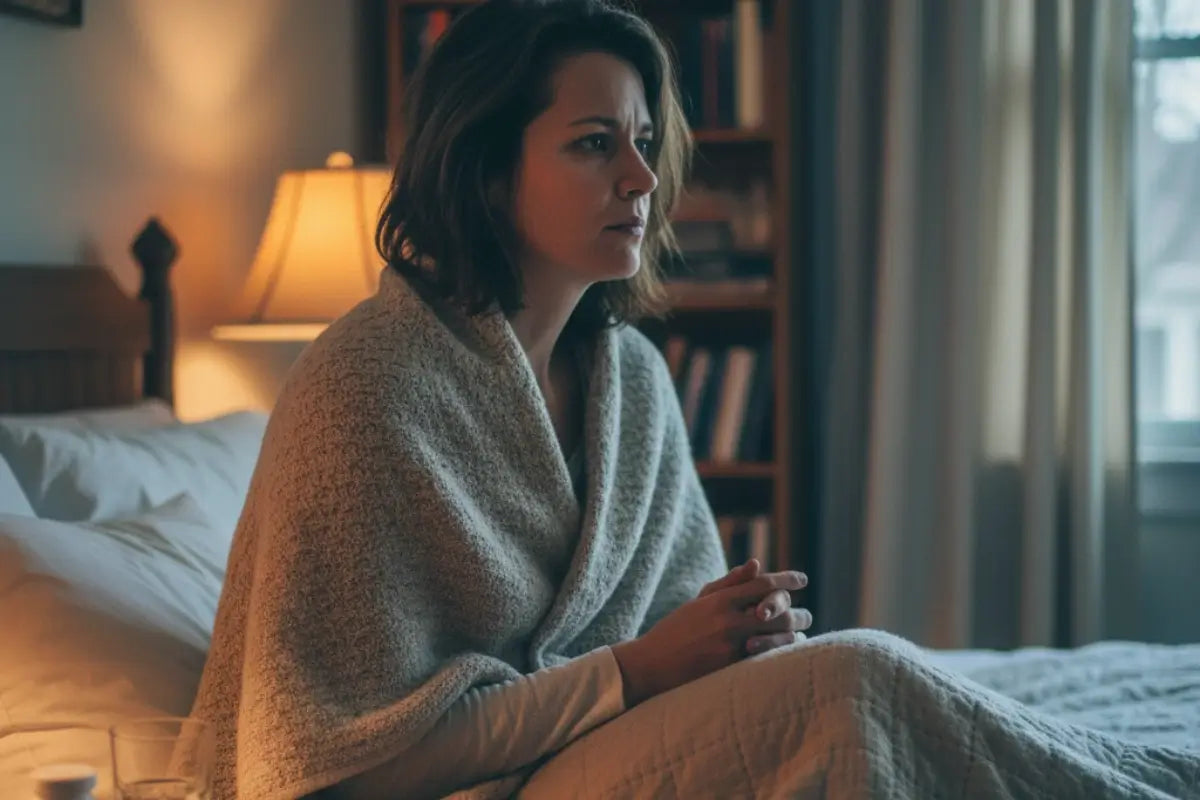Do Heated Blankets Cause Cancer? What Science Says

Fatigue, unexplained weight changes, persistent coughs, or skin changes, these signs of cancer can sneak into daily life, often overlooked until it’s serious.
The fear only grows when everyday comforts, like heated blankets, are suspected culprits.
Could a cozy night’s sleep be risky? Let’s uncover what science really says and separate myth from reality.
Key Takeaways
No Proven Cancer Link: Studies show no consistent evidence that heated blankets cause cancer.
Know the Risks: Burns, overheating, and fire hazards are the main safety concerns.
Use With Caution: Pregnant women, children, and people with diabetes or circulation issues should avoid them.
Safety First: Always choose certified blankets (UL/ETL), inspect for damage, and avoid overnight use.
Safer Alternatives Exist: Layer blankets, use hot water bottles, or add a mattress topper for warmth without electricity.
Do Heated Blankets Cause Cancer? What Science Says
The question of whether heated blankets increase cancer risk has been studied for decades, but the evidence is far from clear.
Research published in the American Journal of Epidemiology looked at over 4,000 women under 55 and found no meaningful link between electric blanket use and breast cancer.
Similarly, risk did not change based on how often or how long the blankets were used. On the other hand, a separate study available on ResearchGate suggested that women who used electric blankets for 20 years or more had a 36% higher prevalence of endometrial cancer.
Yet, another study showed the opposite, reporting a lower prevalence, which highlights how inconsistent the findings are.
Major health organizations, including the World Health Organization (WHO) and National Cancer Institute, emphasize that no conclusive evidence ties heated blankets to cancer.
While WHO advises pregnant women to avoid them as a precaution, experts agree that for most people, modern electric blankets used safely pose little to no cancer risk.

Health Risks of Heated Blankets
Research on heated blankets shows mixed results. Early studies raised concerns about electromagnetic fields (EMFs) possibly lowering melatonin levels and increasing breast cancer risk, but larger studies, like the Nurses’ Health Study, found no consistent link.
Some evidence also hinted at a higher risk of endometrial cancer with very long-term use (20+ years), though findings remain inconclusive.
Beyond cancer, the most immediate risks come from burns, overheating, and circulation issues.
The Journal of Burns has reported injuries from heating blankets in hospital settings, including minor burns and even one fatal case when a blanket malfunctioned.
Overheating may also worsen conditions like Raynaud’s disease, reduce blood flow, or cause dehydration.
Fire hazards are another concern, data from fire safety groups note roughly 500 fires annually linked to electric blankets and heating pads.
Experts cited by Medical News Today recommend avoiding electric blankets if you are pregnant, have diabetes, or circulation problems. Safer practices include preheating the bed and turning the blanket off before sleeping.
Guidelines for Safe Heated Blanket Use
When using a heated blanket, it’s important to balance warmth with safety. Health experts recommend keeping indoor rooms moderately warm, about 16–20 °C (61–68 °F) for babies, 20–22 °C (68–72 °F) for adults, and slightly warmer for older or vulnerable individuals.
Overheating can be risky, especially for infants or those with medical conditions. For reference, fevers are generally defined as a body temperature of 38 °C (100.4 °F) or higher, with infants under 3 months needing immediate evaluation if they reach that point.
To stay safe, always choose blankets with trusted certifications such as UL (Underwriters Laboratories), which tests for fire and electrical safety.
Inspect your blanket regularly for frayed wires, loose plugs, or charred spots, and replace it if damaged.
Pets should be kept away, since chewing wires can create fire hazards. People with diabetes or neuropathy should avoid heated blankets, as reduced sensation can prevent them from noticing burns or overheating. Used wisely, a heated blanket can bring comfort without compromising safety.
Safer Alternatives to Heated Blankets
Layer multiple blankets instead of relying on heat
Using several blankets keeps you warm without electricity. Layering traps air, providing natural insulation.
Two to three layers usually suffice, depending on thickness. Wool, fleece, and cotton retain heat effectively.
Proper layering reduces burn risk and allows easy temperature adjustment. Start with a base blanket, add mid-layers, and finish with a top layer.
Switch to flannel, fleece, or wool for natural warmth
Flannel, fleece, and wool naturally trap body heat and feel soft against the skin. Unlike electric blankets, they don’t require electricity, reducing fire risk and saving energy.
Flannel provides warmth without overheating, wool regulates temperature and wicks moisture, and fleece adds a lightweight, plush layer. These fabrics offer a safe, effective, and eco-friendly way to stay warm at night.
Use hot water bottles or microwaveable heat packs safely
Hot water bottles and microwaveable heat packs can be simple, eco-friendly alternatives to electric blankets, but they work a bit differently.
Electric blankets usually provide steady, widespread warmth across the whole bed, while a hot water bottle’s heat fades after a few hours and stays localized, perfect for warming cold feet or easing muscle cramps.
They’re also more affordable and energy-efficient, since the only cost is boiling water, though they can pose risks like leaks or scalds.
Heat packs, on the other hand, offer targeted comfort and are often used in healthcare to ease stiffness, improve blood flow, and reduce pain.
However, as highlighted by the McGill University Health Centre, burns are a real risk when they’re overheated, applied for too long, or placed directly on bare skin.
To stay safe, choose packs made from durable natural fibers like cotton canvas, ensure seams are strong, and always use a protective barrier such as a towel.
Replacing hot water bottles every couple of years and checking skin regularly can help prevent harm.

Add a mattress topper to trap and retain body heat
A mattress topper can be a simple yet effective way to stay warm without relying on heated blankets.
How much heat it retains depends largely on the material, memory foam and microfiber toppers hold in the most warmth, while wool and latex provide balanced, year-round comfort, and cooling designs with gels or breathable fabrics can even cut down heat buildup by nearly 50%.
Research published in the International Journal of Industrial Ergonomics highlights that topper thickness and firmness affect both body temperature and comfort, with softer 30-mm toppers often striking the best balance.
Wool toppers, in particular, are praised for their natural insulation, moisture-wicking ability, and hypoallergenic benefits, though they require more care and come at a higher price.
Studies also suggest toppers can reduce the need for extra heating by creating a cozy microclimate, which may even lower energy costs.
For cold sleepers, a topper can trap warmth, while for hot sleepers, latex or cooling options help maintain comfort without overheating, all while supporting better sleep quality.
Warm the entire room with a space heater or humidifier
A small space heater can quickly warm a bedroom, and some models can heat larger rooms if placed centrally.
Using a humidifier with a heater makes the air feel warmer and prevents dry skin. Running both together is safe if manufacturer guidelines are followed. This combination keeps your space comfortable for hours without heated blankets.
Stay cozy with heated socks, slippers, or wearable blankets
Wearable blankets, heated socks, and warm slippers provide targeted warmth safely. Heated socks improve circulation and are generally safe for overnight use.
Slippers keep feet warm before bed, while wearable blankets cover the whole body. These options suit people with sensitive skin and allow flexible temperature control.
Choosing between heated socks and a wearable blanket depends on where you feel cold most. Both keep you warm while avoiding burns or electrical hazards.
Adopt simple habits like warm pajamas and closed curtains
While heated blankets are excellent for quickly warming a cold bed and sustaining higher temperatures with adjustable settings, warm pajamas provide a gentler, passive insulation by trapping body heat and maintaining a stable level of warmth.
Fabrics like flannel or fleece can be surprisingly effective in moderately cold conditions, keeping you comfortable without the risks of overheating or electrical devices.
Closing curtains also plays a quiet but powerful role, research in the Journal of Energies found that thermal curtains helped indoor spaces retain more heat, cutting energy use by about 21% while lowering fuel costs and carbon emissions.
Similarly, a study in Energy and Buildings reported that households relying on warm clothing and lower thermostat settings significantly reduced heating demand.
Health experts also emphasize safety: the SleepFoundation advises layering pajamas instead of using loose blankets, especially for children, to prevent overheating and reduce risks linked with electrical heating.
Altogether, simple habits, warm pajamas, layered clothing, and closed curtains, offer a safe, cost-saving, and eco-friendly alternative to heated blankets.
FAQ
Can heated blankets cause skin cancer?
Heated blankets are often questioned for their safety, especially when it comes to cancer risk. Research on electric blankets has mainly looked at the electromagnetic fields (EMFs) they emit, which are low-level, non-ionizing, and not known to damage DNA. Studies have mostly focused on breast cancer and found no consistent evidence of harm. In fact, organizations like the World Health Organization report that everyday EMF exposure from household items, including heated blankets, is considered safe. When it comes to skin cancer specifically, no studies show a direct link. However, long-term heat exposure from blankets can sometimes cause a skin condition called erythema ab igne, also known as “toasted skin syndrome.” In rare cases, this may develop into squamous cell carcinoma, a type of skin cancer. Experts emphasize that newer electric blankets pose minimal risks if used properly, though old or damaged ones can cause burns or fire hazards. As Healthline notes, extra caution is advised for pregnant women, who are often encouraged to avoid overheating.
Can heated blankets cause fires?
Heated blankets can keep you cozy, but they do come with fire risks if not used safely. Reports from the Electrical Safety Foundation International note that heating pads and electric blankets are involved in around 500 fires every year, most often linked to older models that are more than a decade old. Other sources estimate that electric bedding products contribute to as many as 5,000 house fires annually in the U.S., sometimes resulting in injuries or even deaths. Age is a big factor, older blankets often lack modern safety features, making them more likely to overheat or malfunction. Fire safety organizations like the CPSC and NFPA stress the importance of checking for frayed cords, scorch marks, or exposed wires and replacing blankets at least every 10 years. To reduce risks, never fold a blanket while in use, avoid plugging it into extension cords, and only purchase products approved by testing groups like UL or ETL. With proper care, modern heated blankets are safer, but awareness and maintenance remain essential.
How can I safely use a heated blanket to minimize health risks?
Heated blankets can be cozy and help you sleep better in cold environments, but it’s important to use them safely. Medical studies show that prolonged use can raise risks of burns, especially for people with diabetes, poor circulation, or reduced heat sensitivity, since they may not notice excessive heat. Conditions like erythema ab igne (“toasted skin syndrome”) and even increases in blood pressure or heart rate have been linked to overuse. Groups such as pregnant individuals, older adults, or those with chronic conditions should be especially cautious and consult a doctor first. Interestingly, research published in Building and Environment found that partial-body heating systems improved comfort, maintained skin temperature, and even enhanced sleep quality, without stressing the body’s core temperature, when used responsibly. To minimize hazards, choose blankets with UL or CE certifications, avoid folding or leaving them on overnight, and never plug them into extension cords. Inspect regularly for frayed wires and replace older models, since worn blankets cause hundreds of fires annually. Finally, keep the temperature on the lowest comfortable setting, and remember, warmth should never come at the cost of safety.




